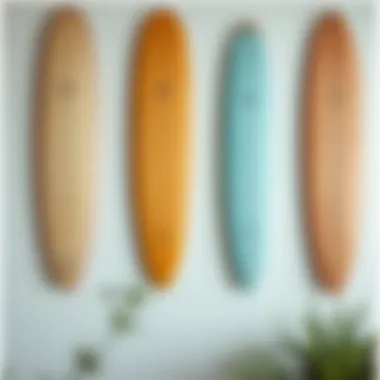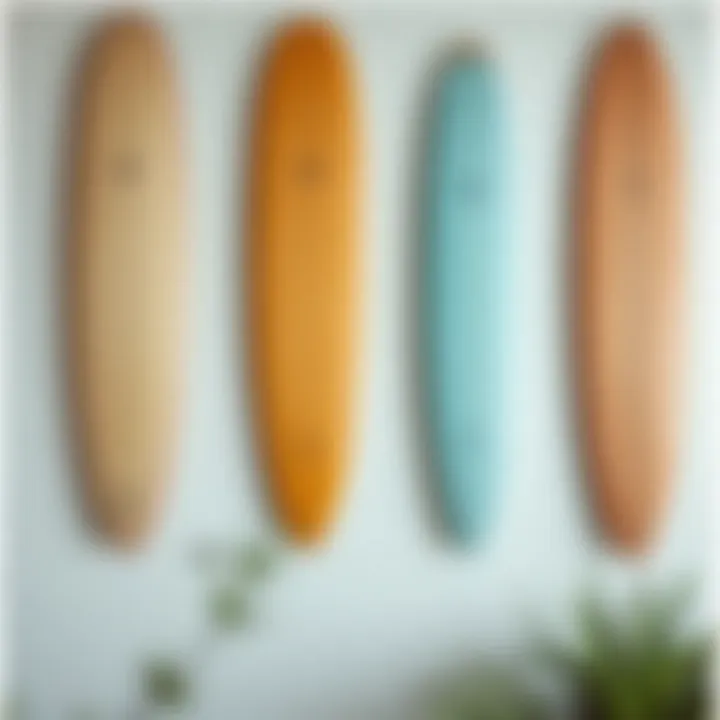Exploring the Aesthetic Value of Surfboards on Walls


Intro
The act of displaying surfboards on walls has evolved. It’s no longer just about the sport; it mirrors a lifestyle steeped in adventure and freedom. For surfers and enthusiasts, these vibrant boards often tell a tale of sun-soaked days at the beach, chasing waves, and celebrating camaraderie. This piece will explore how surfboards can seamlessly transition from functional gear to statement pieces in home decor, enhancing spaces and serving as a conversation starter.
Not only does the display of surfboards infuse a room with personality, but it also underscores a connection with surf culture. The colors, shapes, and patterns often found on these boards can enliven any area, creating an atmosphere that resonates with the spirit of the ocean. Venturing into this topic reveals the synergy between aesthetic choices and practical approaches, setting the stage for a deeper understanding of the implications these objects hold in interior design.
Gear and Equipment
Displaying surfboards on walls isn’t just about aesthetics; it involves using the right gear and equipment to ensure that both the boards and the walls are kept in prime condition.
Latest Surfboard Technologies
While choosing a surfboard for display, it’s crucial to consider modern technology and materials that enhance longevity and appearance. Boards made from epoxy resin are lighter and boast superior durability compared to traditional polyurethane boards. The benefits are twofold: they’re easier to hang and resist warping over time, making them ideal for wall displays.
Materials also play a significant role. Bamboo and fiberglass are popular choices. Their natural textures bring warmth and visual interest. Moreover, innovations such as eco-friendly surfboards made from recycled materials reflect a growing trend towards sustainability, resonating with environmentally-conscious consumers.
Essential Accessories for Every Surfer
To elevate the display of surfboards, various accessories should not be overlooked. Here are some essential items:
- Wall mounts: Look for designs that are both secure and stylish. Options range from sleek brackets to decorative hangers that complement the board’s aesthetic.
- Display racks: A multi-board rack can provide a sophisticated look, allowing one to showcase different boards without overwhelming a wall.
- Lighting: Some discrete lighting elements can accentuate the unique features of the surfboards, casting shadows that highlight their shapes and colors.
"Surfboards are like art pieces; they deserve to be showcased, not stored in a garage."
These accessories not only enhance appearance but also reinforce the simplicity and functionality of accessing the boards when needed. The fusion of gear choices and display techniques opens a world of possibility for both seasoned surfers and casual admirers.
Preface
Surfboards are more than just transportation across waves; they embody a lifestyle rooted in adventure, freedom, and connection with nature. As such, displaying surfboards on walls has increasingly become a trend that adds a unique flair to interior decor. This phenomenon transcends mere sport; it’s about expressing identity and passion. In various settings—whether in a cozy beach cottage, a contemporary loft, or even a trendy coffee shop—surfboards serve as vibrant decor that invites stories, memories, and cultural significance into the space.
Consider the aesthetic value offered by surfboards. Their shapes and colors can transform a blank wall into a captivating focal point, stirring emotions and evoking seaside nostalgia. For homeowners and businesses, this means an opportunity to create inviting spaces that celebrate a surfing lifestyle. When thoughtfully arranged, they do not just hang there; they resonate with life, energy, and a sense of adventure that few other decor elements can replicate.
Moreover, functionality plays a critical role in this trend. It's not just about slapping any board on the wall; careful selection and placement can enhance the overall design of a space. The right mounting techniques ensure that these boards are safely displayed while also allowing them to serve as conversation starters in social settings.
In this article, we’ll explore various dimensions of displaying surfboards as wall decor— from historical context to contemporary techniques and aesthetic considerations. By unlocking the potential of surfboards as artistic elements, readers can embark on a journey of creativity that reflects their individual tastes and lifestyles.
Ultimately, creating a space adorned with surfboards goes beyond decoration. It's about weaving a narrative of adventure and freedom into the everyday environment, making every glance at a wall-mounted board a reminder of sun-soaked beaches and exhilarating rides.
"A surfboard displayed on your wall is a testament to your spirit of adventure, a window into your lifestyle, and an artistic vision all at once."
As we delve deeper into the various aspects of this topic, we aim to furnish readers—particularly surfers, outdoor enthusiasts, and design-conscious individuals—with enriched perspectives and practical insights for incorporating surfboards into their spaces.
Historical Context of Surfboard Design
Understanding the historical context of surfboard design provides essential insights into how these boards evolved not just in their function but also as cultural symbols and decorative elements. The transition from rudimentary wooden constructions to the sleek, vibrant forms we see today has shaped the identity of surfboarding itself. Through exploration of materials and cultural significance, we can see how aesthetics and functionality intersect in ways that influence both professional and casual surfers.
Evolution of Surfboard Materials
Early Wood Designs
Early surfboards were primarily crafted from wood, specifically from types like redwood or balsa. The key characteristic of these designs was their sheer simplicity — boards were often carved out of a single piece of wood, showcasing the craftsmanship involved. While these boards were durable, they often lacked the performance attributes found in modern materials. Their benefit lay in the unique connection they provided to the ocean, embodying the spirit of early surf culture.
However, wooden boards come with drawbacks, especially their weight. A board built entirely of wood can be unwieldy, making paddling and maneuverability difficult. Still, they remain a popular choice for decor, highlighting the rustic charm that many homeowners appreciate.
Modern Fiberglass Innovations
The introduction of fiberglass completely revolutionized surfboard design. Modern fiberglass boards are lighter, faster, and significantly more adaptable to various surfing styles. Their key characteristic is the combination of strength and weight; this innovation not only improved performance in the water but also allowed for creative freedom in design. Surfboards can now feature bright colors and eye-catching patterns, which adds to their aesthetic appeal when displayed on walls.
What makes fiberglass boards a standout choice is their versatility. They can be molded into an array of shapes and sizes, appealing to diverse surf styles. The downside? They can be prone to damage if not cared for properly, leading to repairs that must be done with precision.
Eco-Friendly Alternatives
In recent years, the push for sustainability has led to the rise of eco-friendly surfboard options. These boards are often made from recycled materials or natural resources like bamboo and bio-resin. A defining aspect of eco-friendly surfboards is that they align with the increasing awareness of environmental impact among surfers and beachgoers alike.
These boards serve a dual purpose by contributing positively to the environment while still performing well in the water. They represent a shift in mindset, demonstrating that aesthetic choices can also include a commitment to sustainability. However, they may not always match the performance metrics of traditional fiberglass or wooden boards, meaning surfers need to assess their priorities when considering these alternatives.
Cultural Significance in Surfboarding
Surf Culture Origins
Surfing originates from rich cultural heritage, especially among Native Hawaiian populations, who used surfboards as integral components of their lifestyle. The essence of surf culture can be tied back to its roots in community, celebration, and self-expression. Traditional wooden boards symbolize this heritage, often intricately decorated and passed down through generations, showcasing the connection to the ocean and land.
The importance of these origins lies in their influence on today's surf culture. They guide how contemporary surfers view their sport, merging respect for tradition with modern-day practices. This connection enhances the aesthetic appeal when surfboards are displayed, allowing individuals to represent this rich history in their decor.


Regional Variations
Surfboarding is not a monolith; various regions have put their unique spin on the design and use of surfboards. For instance, the shortboards seen in California vastly differ in style and functionality from the longboards typically used in Hawaii. These regional variations add a layer of depth to their display, as one can showcase boards that tell specific stories from different locales.
The benefit of highlighting these variations in decor is that they promote cultural exchange and appreciation among surf enthusiasts. However, it's important to avoid misrepresenting the culture associated with these boards, ensuring the decor is genuine and respectful to its origins.
Iconic Surfboards Through Time
Certain surfboards have achieved iconic status, defining eras and altering the course of surfboard design. For instance, the longboard of the 1960s, with its smooth lines and ability to ride the curl, has become almost legendary in surf culture. Such boards embody not just functionality but the lifestyle and aspirations of the surfers who ride them.
The allure of iconic surfboards comes from their stories. Displaying an iconic board serves as a conversation starter, linking the past with the present. However, one must recognize that not all surfers are fans of nostalgic practices, leading to debates on modernity versus tradition when displaying surfboards as decor.
"A surfboard mounted on the wall is a story waiting to be told, filled with memories and aspirations tied to every wave ridden and every moment cherished."
Understanding the historical context gives depth to the choices homeowners make when incorporating surfboards into their living spaces. From how materials have changed to the cultural significance tied to each design, these elements not only inform the aesthetic but also create an avenue for self-expression. By intertwining the past with the present, surfers and enthusiasts alike can showcase their passion for the ocean in creative and thoughtful ways.
Aesthetic Appeal of Surfboards as Wall Decor
Displaying surfboards on walls goes beyond simply hanging a board; it's about making a statement and weaving stories into the very fabric of our spaces. The aesthetic appeal of surfboards as wall decor lies in their vibrant colors, unique shapes, and connections to surf culture. Choosing to display these boards allows individuals to express their affinity for the ocean, adventure, and a lifestyle often associated with freedom and thrill. In this article, we delve into how surfboards can transform spaces—from cozy homes to bustling commercial settings—enhancing both the ambiance and the identity of those spaces.
Visual Impact in Various Spaces
Residential Interior Design
Consider the home, a space that breathes personality. When surfboards are integrated into residential interior design, they can serve as striking focal points while echoing the individual’s interests. The key characteristic of residential design is its ability to create comfort. Surfboards add whimsy and character, turning a lifeless wall into a storybook of experiences. Their unique feature comes in the form of diverse styles ranging from traditional wood to vibrant modern designs, giving homeowners options to complement or contrast with existing decor. However, one must keep in mind the overall theme of the home to avoid clashes that may undermine its cozy feel.
Commercial Spaces
In commercial spaces, surfboards bring a lively energy that resonates with customers. Think of beachside cafes or surf shops, where surfboards serve dual purposes as decor and as a means to showcase passion for the sport. The defining trait here is the potential to attract clientele who share similar interests. Surfboards in these environments create an atmosphere filled with nostalgia and connection. Yet, potential drawbacks include the need for careful selection to ensure they align with the brand's image; a decorative board could clash with more sophisticated motifs.
Outdoor Areas
Outdoor areas present a unique canvas for displaying surfboards. Whether mounted on walls of beach houses or incorporated into garden designs, these boards naturally complement the outdoor environment and can evoke that fresh ocean breeze feeling without leaving home. The high visibility is a key advantage, allowing passersby to appreciate the art and lifestyle they represent. However, one must consider durability when placing boards outside, as harsh weather conditions can wear down the materials over time, possibly losing the visual impact they once had.
Combining Art and Utility
Functionality Meets Design
When functionality meets design, surfboards become more than just decorative items. They can be used to store items or to serve as racks. This dual purpose makes them a clever choice for homeowners looking to combine style and utility. A well-placed surfboard rack in a living room not only acts as decor but also provides a place for everyday items like coats or hats. The downside, however, is that often, practical design can compromise the artful aspect. Too many attachments or alterations can shift focus away from the surfboards themselves.
Surfboards as Artistic Statements
Surfboards transcend their practical use as surf equipment, evolving into artistic statements within homes. By showcasing boards with artistic flair, homeowners proudly display their tastes and passions, making their walls pop with creativity. This characteristic of surfboards helps bridge the gap between simple decoration and vibrant expression of personality. Yet, it demands careful selection; an artistic surfboard must resonate with one’s style, lest it becomes an eyesore instead of a centerpiece.
Textural Aspects of Display
Textural aspects of surfboard display introduce fascinating dimensions to interior aesthetics. The smooth and glossy finish of a fiberglass board contrasts greatly with the natural wood grain of traditional styles. Using surfboards as decor offers a rich sensory experience, inviting people to not just look, but to feel and interact with the space. This textural variation adds depth but may require thoughtful placement to ensure it harmonizes with other materials in the room, allowing for a cohesive design while celebrating surf culture.
"Art speaks where words are unable to explain; a surfboard hung on the wall speaks of journeys beyond the shore."
The appeal of surfboards as wall decor is a testament to the intricate blend of aesthetic pleasure and functional purpose they provide. From enhancing personal spaces to creating lively commercial environments, they embody the lifestyle that many aspire to. Understanding how to beautifully position these items within different settings is key to harnessing their aesthetic power.
Techniques for Wall-Mounting Surfboards
Displaying surfboards on walls is not just about aesthetic choices; it requires careful consideration of techniques that ensure safety and functionality. As enthusiasts know, the right methods enhance the visual impact while maintaining the integrity of the boards. This section delves into hardware selection, positioning strategies, and the overall arrangement, which are all crucial for an effective display.
Choosing the Right Hardware
Weight Considerations
When it comes to mounting surfboards, the weight of the board is a fundamental aspect that cannot be overlooked. Some surfboards, especially those made from heavier materials like wood, can exert significant pressure on the mounting hardware. Therefore, selecting robust and reliable hardware is essential. A common recommendation is to go for heavy-duty wall brackets that are rated for the specific weight of the surfboard. These brackets not only provide sturdy support but also ease concerns about potential accidents. Inadequate hardware choice could lead to a board falling, damaging both the board and the wall. Thus, it’s crucial to consider weight carefully when planning your display.
Wall Type Compatibility
The wall type where the surfboard will hang can also significantly impact the installation process. Drywall, brick, and concrete each have unique characteristics. For example, wooden walls typically give more grip and are easier to work with when installing screws or brackets. Conversely, mounting on concrete requires masonry screws or anchors, which can complicate the task. Understanding wall type compatibility means determining the correct fasteners or anchors to use, resulting in a safer and more visually pleasing display.
Safety Precautions
Ensuring the safety of mounted surfboards is paramount. You wouldn't want to see an expensive board crash down unexpectedly. Safety precautions include using appropriate safety gear during installation, ensuring the mounting hardware is securely anchored, and regularly checking connections for wear and tear. Simple measures like these can prevent potential hazards and prolong the aesthetics and life of both the board and the space around it.
Positioning and Arrangement
Centered vs. Asymmetrical Layout
The layout of displayed surfboards significantly influences the overall aesthetic. A centered arrangement creates a sense of symmetry, drawing the eye directly to the board as a focal point. This works particularly well in minimalistic spaces, enhancing the surfboard's beauty without overwhelming the room. On the other hand, an asymmetrical layout can lend a more dynamic feel. It invites the viewer to explore the arrangement as they move through the space. Depending on the room's existing decor, both options can create striking visual narratives.


Groupings and Themes
The concept of groupings extends beyond just a few boards hanging on a wall. Creating thematic displays—like showcasing surfboards from a particular era or region—can evoke stories and emotions. Grouping boards with similar colors or designs can help establish a cohesive look that resonates well with the environment. Individuals may prefer to align boards with their personal adventures, like a collection from their travels. When themes and groupings are carefully considered, they not only communicate an aesthetic but also a personal journey.
Height and Visibility
Where a surfboard is mounted on the wall impacts how it is viewed. Higher placements may showcase the board as a piece of art while making it less accessible. On the flip side, low mounting draws attention and allows for easy interaction, especially if the board reflects cherished memories or achievements. It's essential to find an ideal height that maintains visibility without compromising the board's integrity. For optimal visibility, consider ensuring the center of the board is at eye level, creating a balance between accessibility and aesthetics.
Integration of Surfboards into Home Decor
Integrating surfboards into home decor is more than an aesthetic choice; it represents a bridge between lifestyle and art. The presence of surfboards on walls breathes life into a space, invoking memories of sun-soaked days and ocean waves. When done successfully, these boards can enhance not only the look of a room but also its overall atmosphere. They tell a story, becoming focal points that spark conversations and reflect the homeowner’s personality. Whether you are a surfer or simply appreciate the ocean’s culture, including surfboards as decor can add a significant touch of character and warmth to any environment.
Matching with Existing Style
Modern Minimalism
At first glance, modern minimalism might seem an unlikely match for surfboards, traditionally viewed as colorful and exuberant. However, the key characteristic of modern minimalism lies in its simplicity and functionality. By utilizing monochromatic boards or surfboards in muted shades, one can seamlessly integrate them into a minimalist decor scheme. This approach not only accentuates the surfboard’s shapes and designs but also minimizes visual clutter, creating a calm and collected aesthetic.
The advantage of integrating a surfboard in a modern minimalist setting is the ability to create a strong statement without overwhelming the space. It’s a simple way to blend functionality with design, offering a fresh perspective to an otherwise stark room. However, one must tread carefully; if the board is overly vivid, it may disrupt the meditative tranquility typical of minimalism.
Bohemian Vibes
Bohemian decor thrives on layers, texture, and an eclectic mix of styles. The specific aspect of incorporating surfboards into a bohemian setting is their ability to add an authentic, laid-back vibe that aligns perfectly with the boho ethos. Surfboards, often adorned with bright colors and unique patterns, can enhance the warmth and eclectic spirit of a room.
These boards serve as eye-catching art pieces while still being functional, making them a valuable addition to the decor. This style resonates well with those who appreciate individuality and a carefree atmosphere. However, there’s a unique challenge here: if too many diverse patterns clash, the intended harmony might get lost in a sea of chaos.
Industrial Aesthetics
The integration of surfboards into an industrial aesthetic showcases their versatility. With exposed brick, metal fixtures, and rugged textures, the industrial style provides an intriguing backdrop for surfboards that boast a more rustic or distressed finish. The interplay of hard materials with the organic shapes of surfboards can create stunning contrasts that draw the eye.
The industrial look emphasizes functionality and raw beauty, making surfboards not just decorative pieces but integral elements of the decor. Choosing boards that resemble reclaimed wood or show signs of wear can enhance this effect. However, one must be cautious; if not selected carefully, the rugged nature of industrial design can overshadow the surfboard’s beauty.
Creating a Thematic Space
Beach-Inspired Rooms
A beach-inspired room brings the ocean indoors, and surfboards play a pivotal role in this transformation. Visual elements often mirror the natural beauty of coastal environments: sandy beiges, ocean blues, and coral reds paint a serene escape. Surfboards evoke the feel of sandy toes and salty breezes, which can enhance a room’s overall theme.
This style not only captures the essence of beach living but can also make a space feel more welcoming and relaxed. One unique feature of a beach-inspired room is the incorporation of natural materials alongside surfboards, such as driftwood, seashells, or nautical elements. However, too many beach motifs can create a kitschy feel instead of a tasteful homage to coastal life.
Adventure Zones
Adventure zones are spaces designed to inspire and stimulate. By integrating surfboards into these zones, one establishes a dynamic atmosphere that encourages exploration and excitement. The specific aspect of this theme is its ability to embody the spirit of adventure that surfing represents, infusing spaces with energy.
Adventure zones often thrive on bold colors and movement, making surfboards ideal focal points that capture attention right away. The unique feature of these spaces is their flexibility; they can adapt to reflect personal tastes while still maintaining a cohesive, adventurous spirit. However, balancing the energy can be tricky—too much visual stimulation may lead to a chaotic environment that feels overwhelming.
Color Schemes and Textures
When it comes to surfboard decor, thoughtful consideration of color schemes and textures is paramount. Colors can set a mood, and choosing the right shades means understanding their psychological impact. Surfboards lend themselves to a multitude of hues, from vibrant neons to soft pastels, easily adapting to various design frameworks.
Textures also play a role in enhancing the tactile experience of a space. Whether opting for the sleek finish of fiberglass or the rustic charm of wood, incorporating surfboards allows for a rich interplay of materials. The unique advantage here is that colors and textures can work together to evoke certain feelings or memories tied to surfing and the ocean. Conversely, mismatched colors may create discord, undermining the overall effect.
"The presence of surfboards transforms a space into a conversation starter, blending lifestyle, artistry, and functionality seamlessly."
Materials and Maintenance Considerations
When it comes to showcasing surfboards as wall decor, it isn’t just the aesthetics that matter. The materials used in the surfboards and how they’re maintained play critical roles in their durability and how they fit into your personal space. Proper considerations can enhance the visual appeal while safeguarding the boards' longevity. This section delves into the significant aspects of materials and maintenance that contribute substantially to the overall success of displaying surfboards at home.
Material Durability
Wooden Boards
Wooden boards have a longstanding charm and warm appeal that many surfboard enthusiasts appreciate. Their natural grains offer a rustic aesthetic, making them popular among those wanting to create a homey vibe. A major characteristic of wooden boards is their unique patterns, which lend each piece a distinct personality. Moreover, they can often be customized easily, allowing for personalized colors or finishes that resonate with the owner’s taste.
However, wooden boards come with their challenges. Being more susceptible to moisture and warping, they require good care. If you’re deciding to hang one of these boards, it’s crucial to take care of the environment it’s in to avoid any damage.
Fiberglass Options
Fiberglass boards, on the other hand, are known for their resilience and lightweight properties. These boards are engineered to withstand the rigors of both the ocean surf and the display environment. Their shiny surface provides a sleek look, making them an attractive choice for modern decor. They are often easier to clean, which is a substantial advantage for those looking to maintain a fresh appearance in their homes.
A key downside, however, is that fiberglass can suffer from scratches and cosmetic damage. Depending on the mounting method, potential cracks may occur if the board isn’t handled carefully during installation.
Composite Materials


Composite materials combine various elements to optimize performance and durability. These boards usually harness both the advantages of wood and fiberglass, creating a blend that's both sturdy and visually appealing. They often provide extraordinary flexibility and can handle diverse conditions.
Their modular design is a bonus, as they can suit various styling themes easily. However, since the glue and adhesives used can deteriorate over time, specific care in maintenance and monitoring is necessary, especially if they are displayed in a room with fluctuating temperatures or humidity.
Care and Preservation
Cleaning Techniques
Keeping surfboards clean is essential to preserve their beauty and function. The cleaning techniques employed can dictate how well the boards hold up over time. Using mild soap and water is often sufficient for fiberglass and composite boards. For wooden boards, a gentle wood cleaner is ideal, ensuring that the natural finish isn’t compromised. Always dry them thoroughly after cleaning to avoid any potential water damage.
One might also opt for wax finishing on wooden boards to protect and enhance their appearance. A regular upkeep not only prolongs life but keeps them looking sharp on display.
Environmental Factors
Environmental factors can hugely influence the longevity of surfboards displayed on walls. Increased exposure to sunlight can lead to fading, particularly in colors. Keeping surfboards in shaded areas or using UV-protective coatings can be helpful strategies to mitigate this kind of damage.
Humidity and temperature ranges within your home should also be kept in check. A stable environment can prevent warping, cracking, or peeling, especially for wooden boards which are more sensitive to these elements.
Long-Term Care Strategies
A long-term care strategy is beneficial for making the most of your surfboard’s decorative potential. Storing them correctly when not in use helps maintain their condition. For instance, breathable bags can keep dust at bay while not hindering air circulation.
Moreover, it's wise to inspect the boards regularly for any signs of wear and tear. Early detection of issues can assist immensely in preventing bigger problems down the line. By understanding the materials and committing to good maintenance habits, your surfboards can transition into lasting pieces of your home decor.
Psychological Impact of Surfboards as Decor
The choice to display surfboards as part of home decor speaks to far more than mere aesthetics. It’s about embodying a certain lifestyle, exuding energy, and forging a connection with the natural world. Surfboards serve as vessels of identity, continuously evoking emotions that align closely with freedom, adventure, and community belonging. The psychological fabric woven by these seemingly simple objects is complex yet palpable, influencing not just individual sentiments, but also communal bonds.
Symbolism of Freedom and Adventure
Connection to Nature
When a surfer hangs their board on a wall, they're not just showcasing a piece of equipment; they're portraying a deep-seated connection to the ocean and nature itself. There’s a certain tranquility that accompanies the thought of riding waves. This link to nature transforms a living space into a sanctuary imbued with the essence of the sea. The fresh breezes and the rhythm of the waves can be vicariously experienced even when miles away from the shore. This unique feature of nature-inspired decor provides a sense of calmness, a mental escape, but it may sometimes confront environmental consciousness. People should remain aware of the ecological impact of materials used in surfboards, which can create a pitfall in achieving a fully sustainable living environment.
Nostalgia and Memories
Surfboards on walls can be profound reminders of significant life moments—the first ride on a wave, the serene sunset surf session, the camaraderie shared with friends. This nostalgic element gives rise to profound emotional connections that breathe life into a home. Hanging a board can elevate simple decor to a shrine of memories, inviting guests to share in those experiences. However, while treasured memories can be comforting, the burden of nostalgia might also lead to longing for the past, a bittersweet stance that may detract from enjoying the present.
Inspiration for Creativity
Beyond nostalgia, the mere sight of surfboards can evoke inspiration for creativity. Many surfboards have vibrant designs, showcasing the craft of their makers. They stand as canvases painted by the spirit of the ocean and the culture surrounding it. By incorporating surfboards into home decor, individuals can cultivate an environment that encourages creativity, sparking ideas for storytelling, art, or writing. On the flip side, it’s essential to strike the right balance of decor. Overcrowding a space with boards might dilute the creative intention, overshadowing the very inspiration sought.
Creating a Sense of Identity
Personal Reflection
Displaying surfboards can be a vehicle for personal reflection. Each board can narrate a unique journey—its brand, shape, and design speak volumes about the owner’s preferences and experiences. This self-representation becomes a powerful aspect of home decor, showcasing not only style but also individuality. For those who feel passionately tied to surf culture, these boards become statements of identity. The downside could be that an overemphasis on surfboards might alienate individuals who don’t share such interests, creating a disconnect in varied household dynamics.
Community Connections
Surf culture thrives on community connections. By displaying surfboards, individuals forge a bond with fellow surf enthusiasts, creating an inviting atmosphere for shared experiences and stories. It’s an open invitation for discussions that can spark friendship or community bonding. On the downside, someone might feel the pressure of needing to fit into a specific mold of surf culture or aesthetics to feel accepted within this community, which could lead to feelings of inadequacy.
Style Identity Through Decor
Finally, surfboards shape a particular style identity in a home. They lend themselves to various design trends, from luxurious coastal motifs to minimalistic designs. The unique aspect about choosing surfboards is their versatility—they can seamlessly blend into different furniture styles, unifying decor while establishing a particular ambiance. However, curating this style identity requires careful thought, as mismatched boards can clash with existing decor, potentially diluting the intended aesthetic.
In sum, the psychological impact of surfboards as decor resonates far beyond the visual. Each board tells a story of adventure, fosters nostalgia, inspires creativity, and forges identity. But attention must be paid to the balance and intention behind their display to ensure they positivelly enrich the living space.
Epilogue
In wrapping up our exploration of surfboards as a decorative element, it’s important to underscore not just their aesthetic contribution to interior spaces, but also the deeper significance these boards carry. Displaying a surfboard on your wall isn't merely about filling empty space. It’s a statement about lifestyle, one that resonates with freedom, adventure, and the spirit of the ocean.
Significance of Aesthetic and Functionality
A surfboard on the wall can serve as a focal point, adding character to both residential and commercial spaces. They can be matched with various design themes—whether it's a laid-back beach vibe or a contemporary urban aesthetic, surfboards adapt effortlessly. Their vibrant colors and unique shapes enhance visual interest, while their cultural history offers storytelling potential that can create lasting impressions on guests.
Benefits of Displaying Surfboards
- Personalization
- Conversation Starters
- Sustainability
- Infusing your space with elements that reflect your individuality or passions.
- Guests often find surfboards intriguing, leading to engaging conversations about travel, the ocean, and personal experiences.
- Utilizing eco-friendly materials or repurposed boards adds an environmentally conscious angle to decor, making a commitment to sustainability.
There are practical considerations too—proper mounting and material care are essential for longevity. Preserving these pieces not only maintains their aesthetic quality but also protects the memories and experiences they encapsulate. A well-maintained surfboard reminds us of past adventures and inspires future ones, acting as a conduit for nostalgia and joy.
As we conclude, it becomes clear that displaying surfboards on walls is about much more than mere decoration. It's the intersection of art, function, and identity. The next time you admire a surfboard hanging on the wall, remember the adventure it signifies and the story waiting to be told. Incorporating such a display into your home decor can enhance your living space, making it a sanctuary of memories and aspirations that speaks of love for the ocean and the thrill of the ride.
"A surfboard on the wall is not just decor; it’s a piece of a lifestyle, a reminder of waves ridden and adventures yet to come."
As we grasp the wider implications of surfboard displays, it's evident they encapsulate not just the passion for surfing, but also a philosophy of life—embracing the spirit of adventure and the beauty of the journey.







